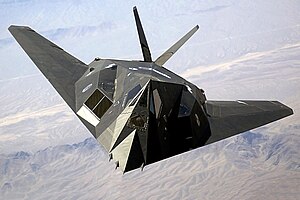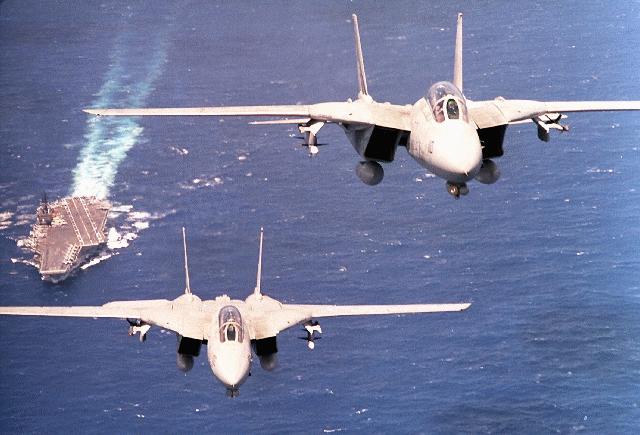rashid.sarwar
FULL MEMBER

- Joined
- Jul 4, 2012
- Messages
- 818
- Reaction score
- 1
- Country
- Location
Makes my head spin 

Follow along with the video below to see how to install our site as a web app on your home screen.
Note: This feature may not be available in some browsers.





Large aircraft such as An-225 and C-5 Galaxy (high wing aircraft) have anhedral to reduce maneuverability, and to stabilize the aircraft. While Harrier has anhedral to increase maneuverability .
For low wing aircraft, such as commercial jets, dihedral is used to increase stability of the aircraft. As seen in the A380 image below.
So, in military aircraft zero dihedral or negative dihedral (anhedral) is used, to increase maneuverability, while positive dihedral is used in large aircraft to decrease maneuverability.




Early design development
During the early design development of the F-16, General Dynamics had considered both single and twin vertical tails. Wind tunnel tests had showed that vortices produced by the forebody strake generally improved directional stability, but that certain strake shapes actually reduced stability at high angles of attack when twin tails were used. It was concluded that a twin-tail format would result in significantly greater development risks and that a single vertical tail would give satisfactory results provided that it was sufficiently tall.
F-16 Versions - F-16 LWF :: F-16.net
There are 2 considerations that have a strong influence on the vertical tail arrangements. Both come into play for rather high angles of attack and occur because of strong vortices which originate near the wing root-fuselage intersection or at a wing leading edge sweep change for some designs. These vortices cause high amplitude buffeting if the tails are too close to them at the most critical angles of attack. The F-14 and F-15 aircraft were strongly affected and had a lot of extra maintenance because of this. The other factor is for certain angles of attack and sideslip one of these vortices impinging on a vertical tail can lead to forces which are in the wrong direction so there needs to be one which is on the upwind side and is completely clear of such wake interactions to guarantee the needed control authority over all angles of attack and sideslip.
"A quick look at the F-22 reveals an adherence to fundamental shaping principles of a stealthy design. The leading and trailing edges of the wing and tail have identical sweep angles (a design technique called planform alignment). The fuselage and canopy have sloping sides. The canopy seam, bay doors, and other surface interfaces are sawtoothed. The vertical tails are canted. The engine face is deeply hidden by a serpentine inlet duct and weapons are carried internally. "
404: Code One Magazine
The wing planform and airfoil design were chosen to minimize weight while providing the maximum turn capability and supersonic cruise. The single vertical tail, however, presented problems in achieving a totally stealthy design. General Dynamics ran many wind tunnel tests to find a location and shape for twin canted vertical tails on the T configuration. The vortex flow off the forebody and delta wing produced unstable pitching moments when it interacted with twin tails. Without horizontal tails, the aircraft did not have enough pitch authority to counteract these moments. A single vertical tail and no horizontal tails was finally identified as the best overall approach to the design despite the degradation of radar cross section in the side sector. The proposal configuration was designated T-330.
A few months before the proposals for the dem/val phase of the program were to be submitted, the Air Force amended its proposal request. The change significantly increased the importance of stealth in the design. Lockheed, with a stealthy configuration derived from the F-117, made no modifications to its design as a result of the new requirements. Boeing made some slight modifications to the design of their inlet to address the increased stealth requirements.The company was, however, satisfied that its twin-tail design would meet the stealth requirements.
The upgraded requirements forced engineers at General Dynamics to again reconsider twin tails in a variety of locations, including out on pods on the wing. The trailing edge of the wing and the control surfaces were cut into chevrons aligned with the leading edge, giving the wing a bat-like look. In the end, no acceptable location for the twin tails was found, and the design was submitted with a single centerline tail and a serrated trailing edge. The new final configuration was labeled T-333.
Note the animation here, demonstrating how the leading and trailing edges of wings and elevators are kept at the same angles to reduce radar signature AND the angles of the engine inlets and the splayed tails are lined up, as well.
http://www.f-22raptor.com/st_fa22tricks.php#stealthfeatures
http://www.f-22raptor.com/st_fa22tricks.php#stealthfeatures




It is one of the many issues and choices made during the design of an aircraft.
Having two vertical stabilizers allow each of them to be smaller than a single one. That in turns allows a reduction of the load at the root, hence a slightly lighter structural strength requirement; shorter tails would also reduce the magnitude of the roll coefficient due to rudder deflection.
In the case of a fighter that could be shot at, having twin units provides a certain measure of redundancy.
But perhaps the most important consideration is that, at a very high angle of attack, twin rudders that are mounted on the edge of the fuselage would not be 'blanked' by the wake of the fuselage, and could retain a measure of efficiency when the flow detaches. This is however done at the expense of a 'buzzing', and interaction from the vortex from the wing leading edge interacting with the vertical tails which, at least in the case of the F-18, was found to fatigue the structural components there, requiring frequent inspection and repairs.
Another aspect is that twin fins do not have to be perfectly vertical, and the angle that they would be set at could be a factor in the reduction of the radar cross section. If you check the F22 and the F-35 (for which twin fins could not have anything to do with helping stability in case of the loss of an engine, since it has only one to start with), the angle is destined to allow stealth.
again i am a layman and might be completely wrong .. sir pshamim would be able to correct my assumptions -- particularly the last qouteAt High angles if attack, sure enough, the VS/Rudders are "hooded" from symmetric flow. This directional sincerity is falling off as the Chines on either side of the forebody start to shed flow rather than direct it. Without these chines, the fuselage would wobble uncontrollably side to side as very high AoA is approached. The Chines do not "energise" the flow to enhance aft controlled Yawing moment, instead, they provide the stability needed to Replace that lost by the "shaded" VS/Rudder.
Source: Design characteristics of canard & non canard fighters

tag mod oscar.I have always been curious to know the machinations behind the minds of designers of fighter jets.
Why do fighter jet designers come up with wildly different designs to essentially do the same job ?
I would like to compare 2 most common wing shapes to better understand why aeroplanes are designed the way they are.
I will start off the thread by enumerating some advantages of both.
Delta Wing
Advantages:
1.Higher Instantaneous Turn Rate(ITR)
2.Better for achieving and maintaining supersonic speeds
3.Higher stall angle
4.More lift.
5.Less wing loading.
6.Stronger than conventional wing, relatively simple and cheaper to manufacture
7.More internal volume for fuel
8.Less stress on the wing, longer life, higher availability and cheaper maintenance.
Conventional Wing:
Advantages:
1.Better Sustained Turn Rate(STR)
2.Better at low speeds.
3.Less air drag
Can anyone care to do a comparative analysis of both, I am sure I have missed many points.


Then why they didn't apply the delta wing instead of the convetional one as They use now?.F-16 vs F16XL
General Dynamics F-16XL - Wikipedia, the free encyclopedia
These changes resulted in a 25% improvement in maximum lift-to-drag ratio in supersonic flight and 11% in subsonic flight, and a plane that reportedly handled much more smoothly at high speeds and low altitudes. The enlargements increased fuel capacity by 82%. The F-16XL could carry twice the ordnance of the F-16 and deliver it 40% farther. The enlarged wing allowed a total of 27 hardpoints:
- 16 wing stations of capacity 750 lb (340 kg) each
- 4 semi-recessed AIM-120 AMRAAM stations under fuselage
- 2 wingtip stations
- 1 centerline station
- 2 wing "heavy/wet" stations
- 2 chin LANTIRN stations
what a beast

I have always been curious to know the machinations behind the minds of designers of fighter jets.
Why do fighter jet designers come up with wildly different designs to essentially do the same job ?
I would like to compare 2 most common wing shapes to better understand why aeroplanes are designed the way they are.
I will start off the thread by enumerating some advantages of both.
Delta Wing
Advantages:
1.Higher Instantaneous Turn Rate(ITR)
2.Better for achieving and maintaining supersonic speeds
3.Higher stall angle
4.More lift.
5.Less wing loading.
6.Stronger than conventional wing, relatively simple and cheaper to manufacture
7.More internal volume for fuel
8.Less stress on the wing, longer life, higher availability and cheaper maintenance.
Conventional Wing:
Advantages:
1.Better Sustained Turn Rate(STR)
2.Better at low speeds.
3.Less air drag
Can anyone care to do a comparative analysis of both, I am sure I have missed many points.
